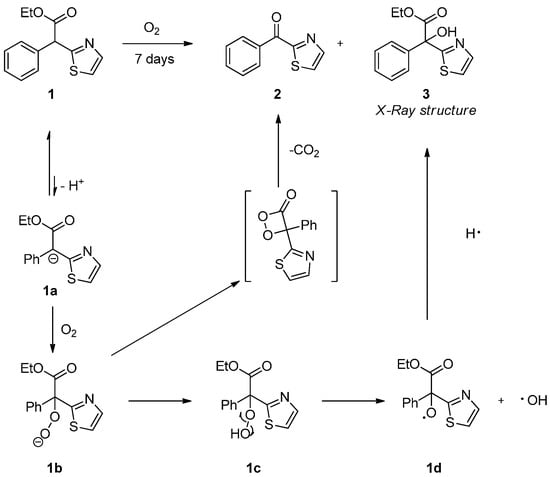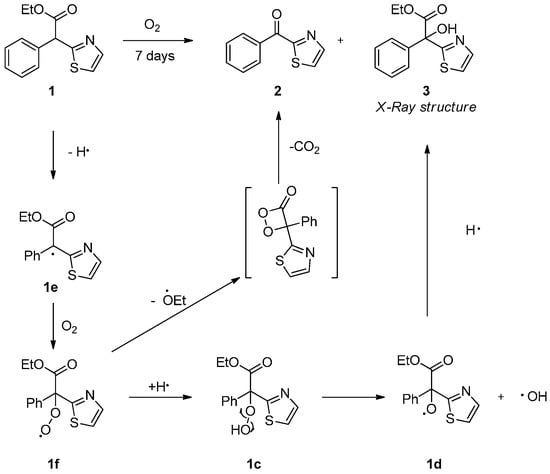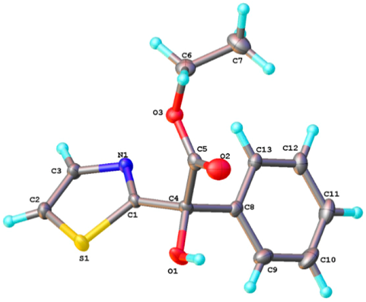Abstract
This short note describes the synthesis of the title compound through spontaneous aerobic oxidation of ethyl 2-phenyl-2-(thiazol-2-yl)acetate. Due to the prevalence of such functional motifs in biologically active substances, we believe the oxidation encountered highlights an important degradation pathway worthy of note.
Introduction
The synthesis of thiazole containing compounds has been the focus of much research due to their importance in both pharmaceuticals [1] and agrochemicals [2].
Recently, we have reported on the synthesis of 2-substituted thiazoles through a modified Gewald reaction [3]. Serendipitously, the natural air oxidation of one of the 2-substituted thiazoles led to an interesting hydroxylated thiazole which yields a glycolate moiety. This previously unreported compound is important because of its implications regarding metabolic and environmental degradation pathways for related compounds.
The air oxidation of 1 slowly gives rise to the corresponding glycolate 3 when simply left standing and open to the atmosphere; the parent compound is stable if preserved under an inert environment. The resultant glycolate 3 can be easily isolated through simple column chromatography purification. Some related oxygenations have been previously described, however, these processes have employed either a palladium catalyst [4] or strong bases such as Cs2CO3 [5] in the presence of oxygen.
In this short note we wish to report on the synthesis of ethyl 2-hydroxy-2-phenyl-2-(thiazol-2- yl)acetate (3) through air oxidation of ethyl 2-phenyl-2-(thiazol-2-yl)acetate (1).
Experimental Section
In a 2–5 mL Biotage™ microwave vial, ethyl 2-cyano-2-phenylacetate (1.46 mmol, 1 equiv.) was dissolved in trifluoroethanol (6.6 mL). After 2 min stirring, 1,4-dithian-2,5-diol (0.73 mmol, 0.5 equiv.) was added and the mixture stirred for 5 min before adding triethylamine (1.61 mmol; 1.1 equiv.) followed by stirring for a further 2 min. The vial was sealed and heated under microwave irradiation for 390 min at 60 °C (conventional heating can also be used and also takes 390 min for full conversion at 60–62 °C). After cooling, the solvent was evaporated in vacuo and the crude residue purified using flash chromatography on silica (EtOAc/hexanes 1:4) to obtain ethyl 2-phenyl-2-(thiazol-2-yl)acetate (1) as a yellow oil (0.30 g, 83%). The material should be stored under an inert atmosphere.
The product 1 was left in a sealed vial at ambient temperature and after 7 days the ratio of the degradation products was analyzed by 1H-NMR (71:5:24 for 1, 2 and 3 respectively). The ratio changed when left for longer periods (>10 months ratio was 26:7:67 for 1, 2 and 3 respectively). The oxidation products were isolated using column chromatography with a solvent mixture of EtOAc/hexanes (1:4). Four fractions were isolated; 2 (Rf = 0.47, 12 mg, 4%) [6], 1 (Rf = 0.26, 41 mg, 14%), 3 (Rf = 0.20, 181 mg, 60%) and an unknown polymeric compound (Rf = 0.07, 48 mg, 16%).
We hypothesise that the two oxidation derivatives (2 and 3) are generated through initial enolisation and reactive trapping of oxygen. Even though no base is present for the deprotonation, the natural enolisation is enough for the reactive trapping of oxygen, albeit rather slowly. The resultant peroxide intermediate 1b could then potentially cyclise onto the adjacent ester moiety forming a dioxetane which, after extrusion of CO2, would furnish product 2 (Scheme 1) [7]. Alternatively, the peroxide intermediate 1c could undergo homolytic cleave to form the oxygen-centred radical that abstracts a hydrogen atom to form the glycolate 3 [8]. It is also possible that compound 2 is the result of ester hydrolysis (water generated in the formation of 3), followed by decarboxylation to yield the simple 2- benzyl thiazole. Such compounds are known to oxidise to their corresponding ketones [9] or undergo a 1,2-rearrangement to form an α-hydroperoxy α-alkoxy ketone which would form 2 after spontaneous decomposition [10].

Scheme 1.
Putative mechanism A for the formation of 3.
An alternative mechanism, not involving the initial enolisation, would be one including an intial homolytic cleavage of the C-H bond, forming a carbon centred radical 1e which can react with oxygen to form the peroxo-radical 1f (Scheme 2). The peroxo-radical can either react with a hydrogen atom to form 1c as part of the formation of 3, or form the dioxetane intermediate to yield 2. Similar to mechanism A, there is nothing that induces the initial homolytic cleavage to initiate the reaction, however, we are convinced that considering the long reaction time needed for the transformation, small amounts of 1a or 1e are naturally formed due to the acidic C-H bond present in 1.

Scheme 2.
Putative mechanism B for the formation of 3.
Spectroscopic Data Compound 3 (Ethyl 2-hydroxy-2-phenyl-2-(thiazol-2-yl)acetate)
White crystalline solid;
1H-NMR (700 MHz, CDCl3) δ/ppm 7.82 (d, J = 3.2 Hz, 1H), 7.73–7.70 (m, 2H), 7.40–7.33 (m, 4H), 4.92 (s, 1H), 4.35 (q, J = 7.1 Hz, 2H), 1.28 (t, J = 7.2 Hz, 3H).
13C-NMR (176 MHz, CDCl3) δ/ppm 172.3(C), 171.9(C), 142.9(CH), 139.6(C), 128.8(CH), 128.3(CH), 126.7(CH), 120.7(CH), 79.5(C), 63.8(CH2), 14.1(CH3).
IR (neat) ν = 3457 (broad), 3118 (w), 2982 (w), 1730 (s), 1494 (w), 1449 (w), 1242 (s), 1173 (m), 1097 (m), 1066 (m), 1012 (w), 733 (m), 699 (m) cm−1.
LC-MS (acetonitrile), Rt. 2.56 min, m/z = 263.9 [M+H]+. HR-MS (+ESI-TOF) calculated for C13H14NO3S 264.0694, found 264.0689 (Δ = 1.9 ppm).
Elemental analysis: calculated for C13H13NO3S C: 59.3%, H: 4.98%, N: 5.32%; measured C: 58.96%, H: 4.95%, N: 5.24%.
Melting range: 95–97 °C (iPrOH).
Crystal structure, CCDC-1049429 (From iPrOH). CCDC 1049429 contains the supplementary crystallographic data for this paper. These data can be obtained free of charge via http://www.ccdc.cam.ac.uk/conts/retrieving.html (or from the CCDC, 12 Union Road, Cambridge CB2 1EZ, UK; Fax: +44 1223 336033; E-mail: deposit@ccdc.cam.ac.uk).


Phenyl(thiazol-2-yl)methanone, 2:
Pale yellow oil;
1H-NMR (700 MHz, CDCl3) δ/ppm 8.49–8.45 (m, 2H), 8.10 (d, J = 3.0 Hz, 1H), 7.73 (d, J = 3.0 Hz, 1H), 7.68–7.61 (m, 1H), 7.56–7.50 (m, 2H).
13C-NMR (176 MHz, CDCl3) δ/ppm 184.3(C), 168.1(C), 145.0(CH), 135.4(CH), 133.8(CH), 131.2(CH), 128.6(CH), 126.4(CH).
LC-MS (acetonitrile), Rt. 2.35 min, m/z = 186.9 [M+H]+. HR-MS (+ESI-TOF) calculated for C10H8NOS 190.0327, found 190.0323 (Δ = 2.1 ppm).
Supplementary Materials
Supplementary File 1Supplementary File 2Supplementary File 3Supplementary File 4Acknowledgments
We would like to acknowledge the funding and support from the Royal Society (to IRB), Syngenta (to CJM) and Erasmus Programme of European Union 2013/14 (to LE), that has enabled this work to be undertaken.
Author Contributions
Carl J. Mallia: Experimental work, writing of manuscript, literature search and synthesis planning; Lukas Englert: Experimental work; Gary C. Walter; Synthesis planning; Ian R. Baxendale: Synthesis planning and writing of manuscript.
Conflicts of Interest
The authors declare no conflict of interest.
References and Notes
- Lamberth, C.; Dinges, J. Bioactive Heterocyclic Compound Classes: Agrochemicals; Wiley-VCH: Weinheim, Germany, 2012. [Google Scholar]
- Baumann, M.; Baxendale, I.R.; Ley, S.V.; Nikbin, N. An overview of the key routes to the best selling 5-membered ring heterocyclic pharmaceuticals. Beilstein J. Org. Chem. 2011, 7, 442–495. [Google Scholar] [CrossRef] [PubMed]
- Mallia, C.J.; Englert, L.; Walter, G.C.; Baxendale, I.R. Thiazole formation through a modified gewald reaction. Beilstein J. Org. Chem. 2015. accepted. [Google Scholar] [CrossRef] [PubMed]
- Chuang, G.J.; Wang, W.; Lee, E.; Ritter, T. A dinuclear palladium catalyst for α-hydroxylation of carbonyls with O2. J. Am. Chem. Soc. 2011, 133, 1760–1762. [Google Scholar] [CrossRef] [PubMed]
- Liang, Y.-F.; Jiao, N. Highly efficient C-H hydroxylation of carbonyl compounds with oxygen under mild conditions. Angew. Chem. Int. Ed. 2014, 53, 548–552. [Google Scholar] [CrossRef] [PubMed]
- 1H-NMR corresponds to literature data from Riekea, R.D.; Suha, Y.-S.; Kim, S.-H. Heteroaryl manganese reagents: Direct preparation and reactivity studies. Tetrahedron Lett. 2005, 46, 5961–5964. [Google Scholar]
- Richardson, W.H.; Hodge, V.F.; Stiggall, D.L.; Yelvington, M.B.; Montgomery, F.C. 1,2-Dioxetane intermediates in the base catalyzed decomposition of α-hydroperoxy ketones. J. Am. Chem. Soc. 1974, 96, 6652–6657. [Google Scholar] [CrossRef]
- Sakurai, H.; Kamiya, I.; Kitahara, H.; Tsunoyama, H.; Tsukuda, T. Aerobic oxygenation of benzylic ketones promoted by a gold nanocluster catalyst. Synlett 2009, 245–248. [Google Scholar] [CrossRef]
- Santos, A.D.; Kaïm, L.E.; Grimaud, L. Metal-free aerobic oxidation of benzazole derivatives. Org. Biomol. Chem. 2013, 11, 3282–3287. [Google Scholar] [CrossRef] [PubMed]
- Sawaki, Y.; Ogata, Y. Kinetics of the base-catalyzed decomposition of α-hydroperoxy ketones. J. Am. Chem. Soc. 1975, 97, 6983–6989. [Google Scholar] [CrossRef]
© 2015 by the authors; licensee MDPI, Basel, Switzerland. This article is an open access article distributed under the terms and conditions of the Creative Commons Attribution license (http://creativecommons.org/licenses/by/4.0/).